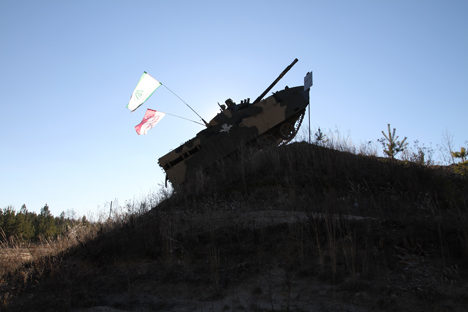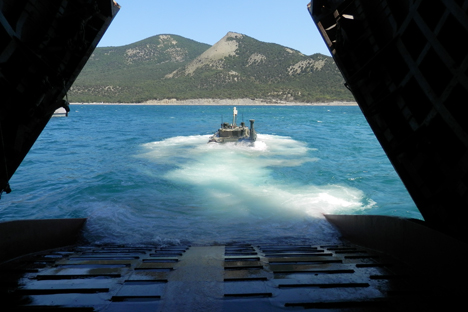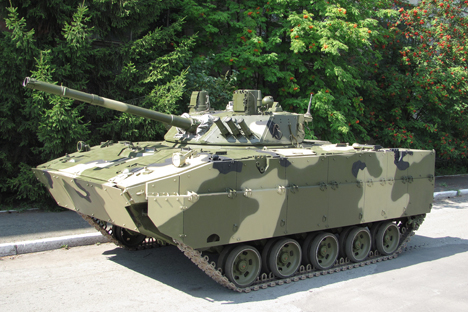
BMD-4M airborne assault vehicle. Source: Concern Tractor Plants
The Russian Army has taken delivery of a prototype batch of the modernized BMD-4M airborne assault vehicle as part of its rearmament. The vehicle, which can be dropped from an aircraft with the crew inside and move into battle immediately deep behind enemy lines, has no equivalent anywhere in the world.
A crushing blow, launched from the skies
The Russian armored vehicle deals the enemy a ‘crushing blow’ in a combat scenario. Thanks to its powerful weaponry, large reserves of ammunition and high speed, groups of assault troops are able to literally ‘drop from the skies’ and overwhelm enemy logistics units.
The first ‘airborne’ assault vehicle for the ‘blue berets’ entered service in 1968. Assault troops are now taking delivery of the fourth-generation vehicle, designed to replace the obsolete BMD-3.
Eight modernized BMD-4M vehicles have been handed over by manufacturer Kurganmashzavod to the 106th Guards Airborne Assault Division (Gvardeyskaya Vozdushno-Desantnaya Diviziya), where the vehicles are continuing to undergo testing.

The BMD-4M can traverse water obstacles without any special preparation. Source: Concern Tractor Plants
The airborne assault troops are Russia’s elite troops and they have had a long wait for a unique fourth-generation vehicle. The BMD-4M differs from its first three predecessors in terms of its more powerful weaponry and its increased reserve of ammunition, which is what the airborne forces really needed, since they do not have tank or artillery support during front line operations.
The new vehicles are able to be launched from an aircraft and reach their allotted targets in a matter of minutes at a speed of up to 45 mph, opening fire from a range of weapons. The BMD-4M is able to cover over 300 miles without refueling. Like its predecessor, the BMD-4M can traverse water obstacles without any special preparation: Afloat, the armored vehicle is able to reach a speed of 6 mph.
Sergei Salnikov, the chief designer of the BMD-4M, remarked on the vehicle’s new capabilities: target acquisition and tracking, and an increased reserve of ammunition.

The new BMD-4 is weighing 13.5 tons as opposed to 8 tons for the BMD-2. Source: Concern Tractor Plants
The strike radius has increased to 4.5 miles as a result of a new artillery gun, which is capable of striking military equipment as well as fortified structures. The automatic reloading of ammunition reduces the physical and psychological burden on the crew, while the automated guidance system can operate in thermal imaging mode.
The 100 mm artillery gun fires Arkan guided PTUR anti-tank shells (protivotankovye upravlyaemye snaryady) almost silently when working at maximum output. These characteristics make the BMD-4M a multi-role, self-propelled rocket and artillery system.
An armored all-terrain vehicle
The track assembly for the BMD-4M is state-of-the-art and easy to control. The gearbox is automatic and the suspension is more balanced, which is very important when there are huge ruts in the road.
Russia’s airborne troops commander, Colonel-General Vladimir Shamanov, declared himself satisfied with the new assault vehicle after sitting behind the wheel and testing it for himself.
“The BMD-1s and BMD-2s would always begin to vibrate, and it was difficult to understand the vibration amplitude, but this vehicle does not vibrate. It is also very stable in the turn and the control system is simple and reliable. I liked the BMD-4M,” said Shamanov.
Thanks to its designers, the BMD-4M is able to negotiate gradients of up to 35 degrees and maintain fire whilst in motion by traversing the turret and keeping the target in its sights.
Overall, in terms of its characteristics this armored vehicle is now beginning to resemble a first class all-terrain vehicle.
The hydro-pneumatic suspension allows the BMD-4M to alter its clearance. The vehicle is able both to hug the ground and rise above it - this is necessary for loading onto an aircraft ahead of a deployment and also for camouflage during combat operations.
No other European countries have pursued the option of parachuting vehicles into battle with soldiers on board, with the exception of France. However, testing was stopped after one of the participants in the tests was killed during a drop.
“Up until now only the Chinese have created an analogue for the BMD-2,” said Viktor Pechenkin, Deputy Chief Designer of the Kurgan Manufacturing Plant (Kurgansky Mashinostroitelny Zavod). Pechenkin added, however, that this vehicle is two generations behind the Russian model.
Testing continues
Yet there are problems with the new Russian design. First and foremost, it is very heavy, weighing 13.5 tons as opposed to 8 tons for the BMD-2.
The Ilyushin Il-76 transport aircraft is only able to accommodate two such vehicles at present, since the troops and ammunition as well as the parachute systems add considerably to the weight of the aircraft. Despite the fact that testing is 51 percent complete, the BMD still needs to complete drops with other BMD vehicles from an aircraft.
There are, however, significant advantages to the modernization of the BMD-4M. A unified armament platform and guidance system for infantry called the BMP-3 has been developed by the Tula Design Bureau (Tulskoye Konstruktorskoye Byuro). This unification makes operation and repair cheaper and easier both in the field and at the manufacturing plant.
All rights reserved by Rossiyskaya Gazeta.
Subscribe
to our newsletter!
Get the week's best stories straight to your inbox